CROP PRODUCTION
Perennial field crop’s production
Coffee production
Scientific name:
i. Coffee Arabica
ii. Coffee Arabica
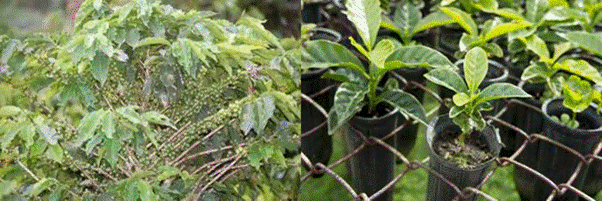
Family name: Rubiaceae
Origin: The plant originated from Ethiopia highlands and was introduced in East Africa towards the end of 19th Century by French and Roman Catholic Missionaries.
Plant Characteristics
o Is a perennial plant with an economic life of more than 70 years.
o Beans of coffee (cherries) found contain 1-1.5% caffeine (as a stimulant beverage).
o The plant produces two types of branches vertical and horizontal branches mainly.
o The plant is self-pollinated.
o The fruit is commonly referred to as a BERRY with two beans (cherries).
o When the berry is ripe the outer skin (exocarp) endosis a shing MUCILAGE (mesocarp) which in turn encloses a rough inner membrane (endocarp), this is commonly known as PATCHMENT enclosing 2 beans. A very thin TESTA known as SILVER SKIN (pulp) add here to each of the beans.
Economic Importance
o The dried beans are roasted, ground and brewed to make a stimulant beverage.
o The coffee pulp and parchment can be used as a manure and mulch once fermented (decay), decomposed.
o The pulp can be fed to livestock and the parchment can be used as deep litter.
o The pulp can also be used for the production of methane gas.
Distribution in Tanzania
i. Kilimanjaro, Arusha, Mbeya – Arabica
ii. Ruvuma, Kagera, Kigoma, Bukoba -Robusta
ECOLOGICAL REQUIREMENT
o Altitude: 1200m-1800m a.s.l.
o Temperature: Optimum temperature is 15c-25c
High temperatures bring fast and soft growth with extended internodes.
Low temperatures the inter nodes shorten and the tree becomes bushy.
o Rainfall: 760mm-2500mm p.a.-Robusta
1500mm-2300mm p.a-Arabica
o Soils: Well drained, deep fertile soil with a pH of 5.2-6.2
NB:
i. Problems associated with low altitude
a. Tendency of continuous production of small flower.
b. stunted growth
c. Crinkling of leaves
ii. Problems associated with low altitude
a. The climate favors pest like Berry borers and diseases like rust
b. Multiple stem pruning cycle becomes too short
c. Coffee quality is usually low.
PROPAGATION
Seed selection
o Seeds must be selected from high yielding mothers which are free from pests and diseases.
o Harvest mature ripe berries (red in colour)
o Pulp and ferment, all flouting seeds must be removed.
o Dry seeds under shade to a moisture content of 18%-14%
Nursery site
o Should be near water source.
o Should be sheltered to prevent wind.
o Should be at a gentle slope.
o Should have deep and fertile soil.
o All weeds, stones must be removed.
Nursery sowing
o Prepare seedbeds of the 1.2m and 10.8m long leaving a path of 0.9m between them.
o Pre-germinate the seeds at later saw them in the seedbeds at a spacing of 15cmx15cm or 20cmx20cm and 2.5cm deep.
o Shade should be provided as well as water should be done.
NB:
Seeds should be planted with flat side down ward.
Seedlings are ready for transplanting 1-11/2 years when they attain 30cm tall.
Transplanting
o Field preparation should start 6 months prior rain season.
o All plant/ tree roots must be removed to avoid the development of Armillaria Mellea fungus which may cause Armillaria root diseases to the crop.
o 3 months to the rain season, transplanting holes have to be prepared.
o Prepare holes of the size 60cmx60cm at a spacing of 2.7mx2.7m (for Arabic) OR 3.3mX3.3m (for Robusta). This is used if shade trees are not used.
o If shade trees are used the spacing in increased to 14mx144m (Arabica) and 22mx22m (Robusta).
o 2-3 weeks before transplanting 1debe of top soil and 1debe of farm yard manure or compost is mixed and filled in the holes.
o A peg is put at the centre of the hole to mark or place where the seedling will be inserted.
o During transplanting roots (especially tap root) must not be bent.
o Mulching should be applied around the stem but not touching the stem.
Advantages of shade trees in coffee field
o Reduces evapotranspiration.
o Most of the shade used is leguminous hence they help to supply Nitrogen to the plant.
o It modifies climate.
o It reduces soil erosion.
o Before the foliage decomposes it acts as mulch and after decomposition it acts as manure.
o Reduces wind effects.
Common shade trees are:
Gravellea robusta
Albizia spp
Cordia Abyssinia
FIELD MANAGEMENT
i. Weeding
a) Common weeds found in common fields are: Couch grass, star grass and Kikuyu grass.
b) Weeding can either be done by cultural method e.g. mulching cultivation using simple tools or slashing.
c) Chemical control involve use of herbicides e.g. paraquat, smazing atrazine, dalopon etc.
ii. Fertilizer application
a) On soil with pH below 5, CAN (Calcium Ammonium Nitrate) should be applied.
b) Soils with pH5-6.5, CAN and NPK should be applied on alternative years.
c) On soil with pH greater than 6.5, SA (Sulphate of Ammonium) or Urea can be applied/ used.
d) The rate of application depends on the soil nutrient level but ranges from 90kg N/ hact -255kgN/ hact
iii. Pruning
This is the act of removing dead branches; pest and diseases attacked branches as well as old branches.
Purpose:
o Improve light penetration.
o Improve spacing
o Disnglish-swahili/courage” target=”_blank”>courage pest and fungal diseases.
o Facilitate application of pesticides.
o Facilitate easy harvesting.
o Facilitate formation of high quality berries.
o Facilitate vigorous growth.
Types of pruning
a) Single stem pruning: This involves retaining the original stem and keeping a height of 1.5-1.8m tall.
b) Multiple stem pruning: This involves retaining 2-4 upright stem.
Stages of pruning
a) Formative stage: This involves establishment of the main work of the tree on which every system of trimming (pruning) will be done.
b) Actual pruning stage: This involves routine ennglish-swahili/courage” target=”_blank”>couragement of vigorous growth of the production of a healthy tree and heavy cropping.
Pruning
Arabica coffee should be grown as a single stem system. Pruning is required to:
supply good healthy wood for the next season’s crop;
maintain the correct balance between leaf area and crop (Figure 27);
prevent overbearing and dieback;
reduce biennial bearing;
Maintain good tree shape.
Desuckering
Year 1
Desucker to maintain a single stem system and avoid competition from suckers (Figure 28).
Remove ‘fly crop’ fruit (early fruit which compete with strong plant/root development) as they appear.
Year 2
Desucker to remove drooping primary branches that touch the ground. Cut back to nearest secondary branch.
Remove secondary branches within 8 inches (20 cm) of the main stem. Remove all fruit as they appear (fly crop).
Year 3
Trees should be allowed to crop in the third year.
Cap the main stem by cutting above a side primary shoot at about 5 ft (1.6 m) from soil level.
Desucker to remove drooping primary branches touching the ground. Cut back to nearest secondary branch.
Remove secondary branches within 8 inches (20 cm) of the main stem.
Maintain a maximum number of well-spaced secondary branches on each primary branch.
Remove all dead, weak and spindly pest or disease damaged branches.
As plants grow, they can become too crowded and suffer loss of production. Alternate trees can be stumped by cutting off at knee height – about 20 inches (50 cm) from soil level. When these trees are producing again after two years, stump the remaining trees (see notes on stumping).
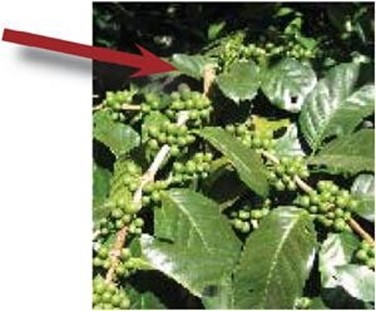
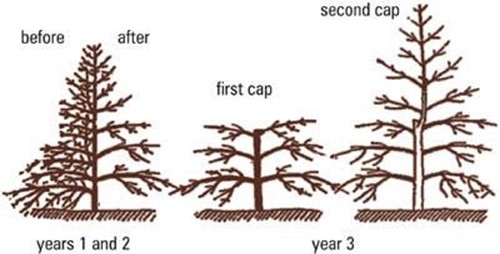
General pruning and desuckering of tree over years 1 and 2. Capping during year 3. Newly capped tree photo (above)
Rejuvenation (Change of cropping cycle)
A regular rejuvenation pruning is needed (normally at six to seven years depending on tree vigor and yield pattern), to maintain a source of new fruiting wood. Unless trees are renewed, yield will decline over the following years.
Two rejuvenation methods are used:
o Side pruning
o Full stumping
Side pruning
This involves removing one side of the tree, training a new sucker and then removing the other side of tree two years later. This method is recommended for all growers, as only 50% of the crop is lost for the two-year period.
Two years before stumping, remove all branches on the eastern side of tree after harvesting. Select a new sucker approximately 12 to 18 inches (30 to 45 cm) from the soil level, and train the shoot by thinning as described for a new planting (Stages 1 and 2) until bearing a crop (Stage 3).
Two years later, stump the older stem above the new stem. Cut at a 45° angle – do not cut straight (Stage 4).
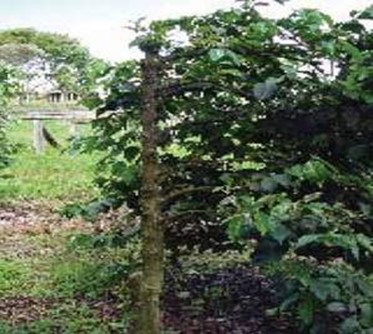
A coffee tree after being side pruned

The four stages in side pruning a coffee tree

Diagram of full stumping procedure. Choose the strongest shoot and remove the rest; note the
45° cut angle. Photograph of a stumped tree after re-growth (left)
Remove all young suckers from the main stem.
Remove all secondary branches around primary braches within 15cm, from the main stem.
Remove all dead, diseased, pest attacked and non-bearing branches.
o The final result should be 170cm and wide enough to allow light penetration.
iv. PEST AND DISEASE CONTROL
a) Pests
i. Leaf1 minor: Leucopters spp
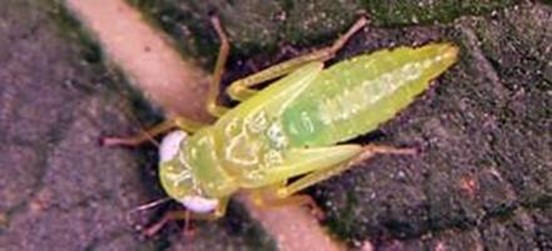
Damage: The larva bone into the leaves and feed on the palisade tissues. Brown blotches appear on the leaves.
ii. Antestia bug: The suck the berries causing longitudinal/ zebra stripes and defoliation of buds.
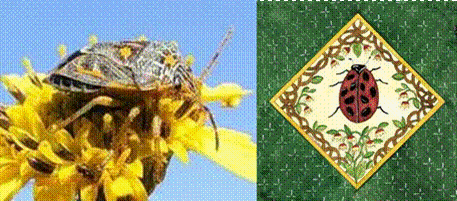
o Other pests include
Berry moth
Meanly bugs All are sucking insects
White scales
Thrips
General control: Timely spraying of insecticides e.g. Dursban, Dictofos, Dieldrin etc at a rate of 1litre/ hact.
b) Diseases
i. Coffee berry disease
Cause: Fungus known as Collelotrichum coffeanum
Symptoms:
The fungus causes the formation of necrotic lesion which turns to brownish rings on leaves.
On fruits they become blackish, skrikelled and later drops.
The fungus is spread by rain drops or wind.
Control:
Cultural methods:
Pruning the affected branches to lower the humidity.
Remove fruits resulting from season flowering.
Proper supply of nutrients to plants to increase resistance to the disease.
Chemical methods:
Use of fungicides e.g. Cobox 500WP, Sandox 500WP, Nodox 500WP, Perenox, Bravo.
ii. Coffee leaf rust
Cause: Fungus known as Hemilleria Vastatrix
Symptoms: Yellowish pustules on the leaf causing defoliation.
Control:
Cultural control
Chemical use of fungicide e.g. Bravo
Other Diseases:
Wilting (die back)- Fusanium stiboides
Armillaria root rot- Armillaria melea
v. HARVESTING
o Through picking
o Done by hand when cherry is uniform ripe, over ripe, berries (dark) may be difficult to pulp.
o Unripe berries (green) may not have enough mucilage for effective pulping.
o Berries of mixed ripeness cause un even fermentation.
o Yellow berries produce poor quality. Process after picking
Two methods
a) Dry method
b) Wet methods
Dry methods (Buni)
Can be done in two ways
i. The berries can be left to dry out in the field then collected on the tree and ground as BUNI
ii. Berries can be picked and dried on the sun in raised trays.
Wet method (Arabica)
o Cherries are fed with water into pulping machine which separates beans from the skin.
o Parchment coffee is left for 2-4 days in fermenting gas where the sticky mucilage is removed by being broken down by enzymes.
o Beans are wished to get rid of the broken berry mucilage.
o Drying is done under the sun.
Yield:
Average 800kg/ ha-1250kg/ ha
NB:
o Robusta coffee is grown in low altitudes about 1100-1400m a.s.l the tree have vigorous growth has large coarse leaves with convagated surface contrary to Arabica which have flat surface.
o Robusta has characteristics (features) of heavy bearing, if it is not attacked by many pests and diseases.
o Many growths leave the tree unprunned because the tree does not suffer from over bearing as for Arabica.
o The crop is sold as sundried cherry which is hulled at factories.
Yield:
1900kg/ ha or more
TEA
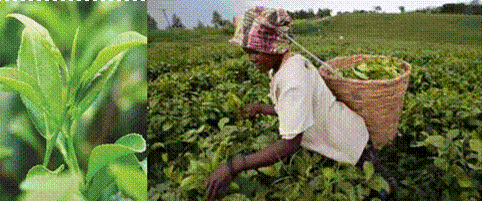
Scientific name: Camllia Sinensis
Variety:
Sinensis
Camellia Sinensis variety
Sinensis Assamica
Origin: China
Major producers include- India, Taiwan, Argentina, China, Kenya, Thailand, Malawi, Mozambique, Uganda, Zaire, Mauritius and Tanzania.
Distribution in Tanzania
Tukuyu, Mbeya, Mufindi.
Uses
Used as a beverage
For medical purposes. (Extraction of fluorine)
Characteristics of ASSAM tea Camellia sinensis var assamica
Grow up to 9m high.
Adapted to tropics.
Have high fast growth
High yield
Have pale green leaves.
Flowers are born in clusters of 2 and 4.
Characteristics of CHINATEA Camellin sinensis var sinesis
Dwarf, never grow than 4.5m
Adapted to sub-tropics.
Low growth rate
Narrow leaves which markedly serrated
Dark green leaves
Low yield
Flowers born singly